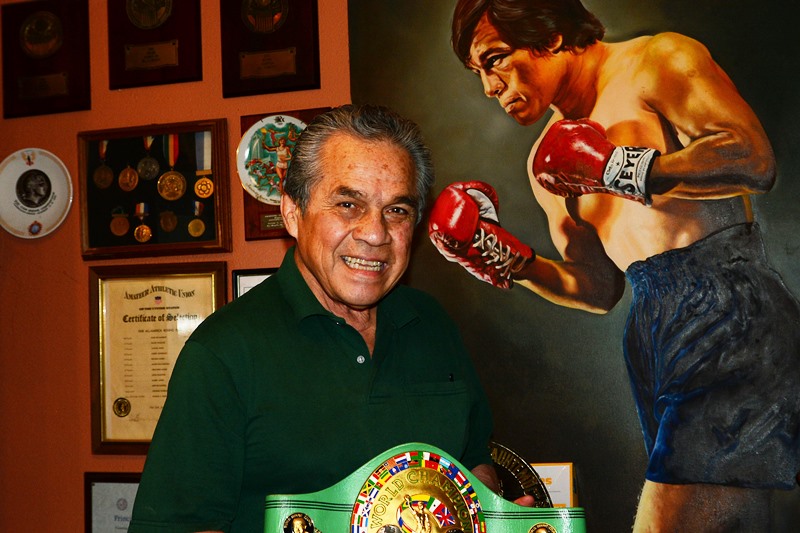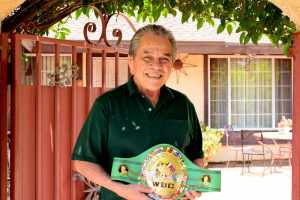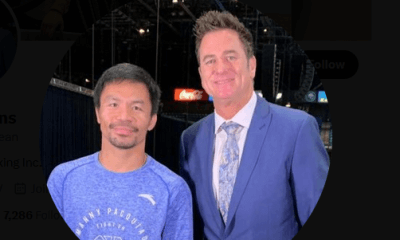Featured Articles
Uncrowned World Champion Series: Armando ‘The Man’ Muniz

Uncrowned World Champion Series: Armando ‘The Man’ Muniz
Belts, belts, everybody has a belt.
Until the 1980s there were only two world title belts in each division. It was extremely difficult to become a world champion.
Control of the world title was even more politically charged than it is today.
It was during this period on March 29, 1975, that Armando Muniz ventured to Acapulco, Mexico to face Jose “Mantequilla” Napoles and discovered that beating a world champion to a bloody pulp was not enough. In befuddlement he walked out of that battle without the WBC and WBA welterweight titles. Fans who later saw the fight on television were angered by the outcome.
Despite public outcry the WBC refused to overturn the egregious decision.
That fight remained the closest Muniz ever came to being the actual world champion though he fought several times for the WBC belt. He was not the first and definitely not the last to become an uncrowned world champion.
It gnawed at Muniz for many years who later met with WBC president Jose Sulaiman in Los Angeles to discuss it.
“We had a conference at an office in Van Nuys. And he told me ‘You don’t understand. Napoles was my friend.’ So I said, oh really. What was I,” said Muniz. “I knew he felt bad about it. But the damage was done.”
During his fighting days Muniz could fill those seats at the Olympic Auditorium. All that was necessary was to put his name on the large marquee outside of the building on the corner of 18th Street and Grand Avenue in downtown Los Angeles and fans would buy tickets.
“I guess I kind of had the style people like to see,” Muniz says.
Muniz was a go-getter type of personality who after serving the U.S. Army went directly into prizefighting with a pressure boxing style that could bend steel. He quickly climbed up the welterweight ladder into contention. Quickly. He was 24 years old.
Aside from diving into prizefighting, Muniz also enrolled at Cal State University of Los Angeles and attended classes to obtain a Bachelor’s degree. He was a go-getter.
1968 Mexico City Olympics
Born in Mexico but raised in Los Angeles, the Muniz family moved around and while at Artesia High School the future prizefighter met friends who helped guide him toward his eventual career as a professional boxer.
While in the US Army, Muniz had represented the US Boxing team in the 1968 Olympics at Mexico City. Though he did not medal he was there to witness George Foreman win the heavyweight gold medal. He was also witness to the Black Power salute by Black athletes Tommy Smith, John Carlos and Lee Evans. During these Olympic Games student demonstrations were taking place throughout the city and were violently put down by the Mexican government. Many lives were lost.
Boxing had provided Muniz with options while in the U.S. Army and as soon as he departed he looked for a place to continue in the boxing world. He found a gym at the Teamsters Gym in downtown L.A. and also found a manager and trainer there.
“I told him I would fight anyone,” said Muniz of his manager Louie Jauregui. “If I can’t beat them than why am I fighting?”
That became Muniz’s mantra.
“I remember my first fight against Joey Adams I knocked him out in the third round,” said Muniz of his pro debut that took place July 1970 at the Olympic Auditorium. “I made $200 and $100 went to me.”
His fierce fighting style and come-forward aggression quickly gained him fans. In his mere fifth pro fight he was asked to face a Philadelphia fighter named Bobby “Boogaloo” Watts. It was the same fighter that later famously battled with future middleweight champion Marvin Hagler in the famous “Phillie Wars.”
Muniz defeated Watts after six angry rounds at the Olympic Auditorium. After only two more six-round bouts he was headlining 10-round main events at the famous fight arena headed by Aileen Eaton.
He picked up a nickname that suited him well. Muniz became known as “the Man” or “El Hombre.” Every time he fought, fans expected a good fight and he delivered.
“My favorite fight was probably with Oscar “Shotgun” Albarado. I wasn’t supposed to win. He could hit hard with both hands,” said Muniz of the fight that took place on May 6, 1971 at the Olympic Auditorium. It was a 10-round welterweight fight that ended in a split draw. “We filled the seats.”
Crowds continued to fill the seats as Muniz faced top competition wherever he fought against Gil King, Clyde Gray, Emile Griffith and Adolph Pruitt in places like Long Beach, California and Anaheim. He also fought in Las Vegas, Denver and Tucson.
A win over the talented Hedgemon Lewis on December 1974 at the Inglewood Forum set Muniz up for the world title challenge against Napoles three months later. The Los Angeles-based fighter was a 10-1 underdog.
Mexican hospitality
Though Muniz was born in Chihuahua, Mexico he was not treated fondly by Mexicans when he arrived at the press conference in Acapulco. Despite having Mexican blood the Mexican fans preferred Cuba-born Napoles who had adopted Mexico City as his home after the Cuban Revolution in 1960.
For many, Muniz was the Chicano from California brought to be a punching bag for the great Mantequilla.
The term “Chicano” was used to describe those of Mexican blood who lived or were born in the U.S. Some adopt the term and some abhor it. Many in Mexico still use the term Chicano or other words to describe Mexicans living in the U.S.
Muniz never cared what others thought, he always believed in himself.
“I knew I was always in tremendous shape,” said Muniz who credits his wife as a major reason for his ability to concentrate on training.
Right from the opening bell Muniz showed no timidity as the slick fighting Napoles seemed puzzled by constant pressure. In the second round Napoles began using various tricks including head butts to stave off Muniz’s attacks. Cuts opened up on the world champion by the third round.
Round after round Muniz pressured intelligently and despite various Napoles fouls the Mexican referee only admonished the Californian. By the 10th round the champion slowed down visibly and Muniz began busting up Napoles with big solid blows. A few staggered the Cuba-born fighter and the end was near.
Blood was everywhere including on Muniz’s trunks. The referee seemed worried and from outside of the ring WBC head Jose Sulaiman can be seen shouting instructions to the referee Ramon Berumen. During the 12th round the fight was stopped. Napoles was declared the winner and the Mexican audience cheered Napoles who looked more like the victim of an East L.A. mugging.
“I was looking at my dad. He said it was incredible that we lost the fight. It was just a bad decision. I think I’m naturally a nice guy. I didn’t rebel. They robbed me and I didn’t make a big stink about it,” said Muniz. “Ninety percent of the people thought I won.”
Despite public outcry throughout California the decision was not overturned.
“I think Jose Sulaiman said this was his decision. So I lost the fight,” said Muniz of the decision in Mexico. “Napoles could do no wrong. He was like a God down there. Even in the town I was born they adored the guy.”
Final count
Muniz would fight three more times for the world title including a rematch with Napoles. All ended in losses for the fighter known as “the Man.”
Knowing he should have won the world title that night in Acapulco could have destroyed Muniz. But he later used his earnings to move to Riverside. He made $15,000 for his fight with Napoles and would later make $30,000 for his last fight against Sugar Ray Leonard. It was the most he ever earned from a prize fight.
“I owe a lot to my wife,” said Muniz who is often guided by his wife to make the right decision including to become a high school teacher. “I couldn’t ask for anything more.”
Muniz lives in a Spanish style house near picturesque hills in Riverside, California. He’s been retired for many years as an educator. One special note was when he fought Carlos Palomino for the WBC welterweight world title in 1978, both were college graduates. It was the first time ever two college graduates fought for a world title.

A few years back an old friend named Dub Harris received a WBC world title belt from Mauricio Sulaiman who succeeded his late father Jose Sulaiman as the head of the WBC organization. Harris was told to give it to Muniz.
Now the green WBC belt hangs on display at the Muniz home in Riverside.
“Once a guy asked me why I was given the WBC belt,” said Muniz puzzled by the question from the person. I looked at him and said “because I won it.”
Photos credit: Al Applerose
Check out more boxing news on video at The Boxing Channel
To comment on this story in The Fight Forum CLICK HERE
-

 Featured Articles2 weeks ago
Featured Articles2 weeks agoResults and Recaps from New York Where Taylor Edged Serrano Once Again
-

 Featured Articles2 weeks ago
Featured Articles2 weeks agoResults and Recaps from NYC where Hamzah Sheeraz was Spectacular
-

 Featured Articles2 weeks ago
Featured Articles2 weeks agoFrom a Sympathetic Figure to a Pariah: The Travails of Julio Cesar Chavez Jr
-

 Featured Articles2 weeks ago
Featured Articles2 weeks agoPhiladelphia Welterweight Gil Turner, a Phenom, Now Rests in an Unmarked Grave
-

 Featured Articles3 weeks ago
Featured Articles3 weeks agoCatterall vs Eubank Ends Prematurely; Catterall Wins a Technical Decision
-

 Featured Articles5 days ago
Featured Articles5 days agoManny Pacquiao and Mario Barrios Fight to a Draw; Fundora stops Tim Tszyu
-

 Featured Articles3 days ago
Featured Articles3 days agoArne’s Almanac: Pacquiao-Barrios Redux
-

 Featured Articles1 week ago
Featured Articles1 week agoFrom the Boondocks to the Big Time, The Wild Saga of Manny Pacquiao’s Sidekick Sean Gibbons














